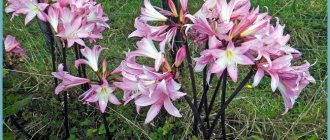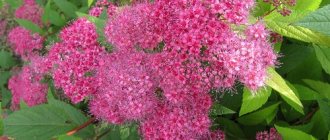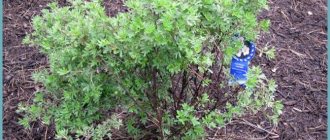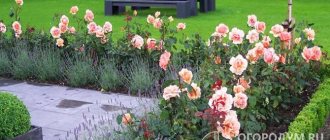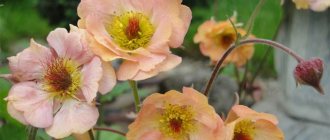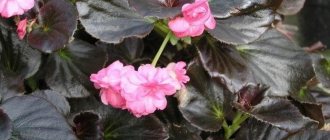Many gardeners prefer to grow the beautiful helenium plant on their plots. There are about 40 species of representatives of the genus Helenium perennial or annual, differing in height, shape, color of leaves and flowers.
Helenium is a long-standing representative of the Astrov family. Its homeland is North and Eastern America, where it is a fairly common garden plant. This beautiful flower pleases with its variety of colors and shapes. Perhaps this is why in Russia there is increased attention to varieties of this species. Planting and care will not be difficult; with proper attention, perennial helenium will delight you with abundant flowering.
What does a helenium flower look like?
Helenium is a bright decorative flower. The plant belongs to the Asteraceae genus. There are more than 30 types of heleniums, which differ in height, shape and size of flowers, and flowering time. Only 2 types of plants are popular in the CIS countries. These are picky perennials that gardeners love.
Helenium perennial.
Heleniums bloom for a long time - from one and a half months. By planting an area with several species, you can get a blooming flowerbed from June until frost. The plant tolerates heat up to 40 degrees and frost.
Yellow
Helenium yellow differs from other species in its abundant flowering. Flowers can range from golden to almost brown. At the same time, the petals are yellow and bright, but closer to the core they darken. Helenium yellow blooms in autumn. The flower is chamomile. The diameter of the inflorescence is 6 cm. The stems of the plant can reach 2 m. They break at the end.
The most popular varieties: Double Trouble, Canaria, Goldraush, Bishop.
Orange or brown
Rubinkuppel - yellow-brown flowers up to 1.5 m high.
Rubinkuppel.
Moerham Beauty - Heleniums, the flowers of which are red-brown in color. Plant height up to 80 cm.
Moerheim Beauty.
Rubincverg is a variety whose stem height is up to 50 cm. The plant loves the sun, rich in nutrients and moist soil. Blooms from June to September.
Rubinzwerg.
Two-color
Helenium bicolor is an autumn flower up to 150 cm high. The flowers are 5 cm in size. The stem is strong. The plant is often unpretentious and tolerates heat and frost well.
Rauftopaz: brown baskets. The petals are yellow at the ends, orange towards the middle. Height 1 m.
Rauchtopas.
Fursigel reaches a height of 1.2 m. The flowers are yellow-red.
Feuersiegel.
Flammenrad - yellow-orange flowers about 1 m high.
Flammenrad.
Low grades
Although most Heleniums grow 1–2 m tall, there are shorter and more compact varieties:
- Crimson beauty. Height 60 cm. Flowers orange-red.
Crimson Beauty. - Red Army is distinguished by red flowers and brown baskets. Height 60 cm.
Red Army. - Golden Jugend is a yellow flower 0.8 m high.
Golden Jugend.
Varieties and photo gallery of perennial helenium
Beautiful varieties have been bred from autumn helenium, of which 5 varieties are the most famous.
Moerheim Beauty
The variety is notable for the fact that in buds the flowers can have shades of copper, golden, yellow and red. The blossoming flower turns red-brown. Helenium Moerheim Beauty blooms in July and decorates the garden with its bright flowers until frost.
Pictured is Helenium Moerheim Beauty
Autumn serenade
This is a mixture of helenium seeds, the velvety flowers of which come in a wide variety of shades. However, you can see their coloring in the photo. An excellent option for decorating an autumn garden.
Helenium autumnale
Cockade
The plant, more than a meter tall, blooms for about a month and a half from the beginning of August. This variety has very beautiful flowers of unusual color. Their center is yellow-brown, and the red petals are brown on the edges and dark red toward the center.
Pictured is Helenium Kokarda
Rubincverg or Helenium Ruby Dwarf
The variety is distinguished by stems about 60 cm high, dense bush structure and bright ruby-colored flowers, which begin blooming at the end of June.
You will be interested to know: Shelter for the winter of young hydrangea 1 year of planting: when and how to cover
Rubinzwerg
In the photo there are flowers of helenium Ruby gnome
Rubinzverg
Waltrout
A chocolate center and red-orange large petals are all descriptions of the colors of the autumn helenium variety Waltraut. Flowers are formed on compact bushes, the height of which is no more than 60 cm. Flowerbeds are decorated with bright Waltraud from July to September.
Pictured is Helenium Waltraut
Waltraut
When it blooms
The flowering period of helenium depends on the variety and climatic conditions and can vary from early summer to frost. Therefore, when planting, it is recommended to combine several species that bloom at different times.
Early varieties that bloom all summer
Early types of helenium include:
- Pumilum Magnificum has bright yellow flowers. Plant height is 0.6–0.8 m.
Pumilum Magnificum. - Moyerheim is a plant with copper-red, brown, lens-shaped flowers. Height 0.7–1.2 m.
Moerheim. - Vesergold - helenium 55–120 cm high. The flowers are yellow, tubular-brown, bunched.
Wesergold. - Waltrauts are perennial orange-yellow, lens-shaped flowers. Height 0.8–1 m.
Waltraut.
Varieties that bloom from late July to early September
Plants with an average flowering period include the following varieties:
- Helenium autumnale is a perennial yellow tube flower, 0.6–0.9 m high. Helenium autumnale.
- Goldraush is a plant with golden yellow flowers. Height 1.4–1.5 m. Flowering period until the end of August.
Goldrausch. - Biedermeier is a helenium with red flowers with a yellow border. Height 1–1.6 m. Blooms until the end of August.
Biedermeier. - Helena - varieties ranging from yellow to dark red in color. Height 0.5–1.2 m. They begin to bloom from the first year when sown with seeds. Flowering period - until October.
Helena. - Mariachis are perennials with dense bushes. Flowering period - until the end of September.
Mariachi.
Late varieties, blooming in August and September
Few plants can boast of blooming in the fall. Among Heleniums there are such varieties. They will enhance and complement the beauty of the autumn garden.
The most famous varieties:
- Boudirector Line is a perennial plant with red tubular and lenticular flowers. Height: 1–1.2 m.
Baudirektor Linne. - Bandera is a variety with red flowers in a yellow frame. They are distinguished by their small height (40–50 cm).
Bandera. - Wild form - helenium 0.8–1.5 cm high. Inflorescences are yellow.
Wildform.
Description of the species
Hybrid helenium perennial is one of the most common species of the genus helenium from the family Asteraceae. The plant forms a large, strong bush, with spreading shoots.
Table. Main characteristics of Helenium
| Characteristic | Description |
| Height, shape | The plant grows to a height of 1.5-2 meters, has thin, highly branched shoots, and a lush shape. |
| Leaves | Green, lanceolate, glandular, spotted, jagged. The foliage dries out when the plant begins to bloom and may have a lot of dry leaves, but this is not a problem - due to the height of the bush, helenium is usually planted at the back of the flowerbeds. |
| Height | Plant growth is rapid, shoots often bend and fall to the ground, requiring support. |
| Trimming | To delay flowering for about 2 weeks, part of the plant’s stems is cut off in May-June, and the cut shoots are used for propagation. |
| Bloom | The flowering period of helenium is long (June-October). The first flowers appear at the ends of the shoots in June and develop continuously until late autumn (the end of flowering is October). At the top of each shoot, a single flower appears with a strongly protruding, almost circular flower head and small, slightly curled petals, giving the appearance of a small, colorful fan. |
| Inflorescence | Flower baskets are 3-5 cm in diameter, the edges are yellow, yellow-brown or brown-red, there are 3 separate teeth at the end of the petal. The tubular flowers, yellow or brown, are compact and form a dome-like inflorescence inside the inflorescence. There are varieties and varieties with yellow, red, brown, and orange stripes. The color, height, and size of flowers depend greatly on the variety. |
Be careful! Plant heleniums away from small children, the plant causes skin allergies and poisoning.
How to grow helenium from seeds
Heleniums prefer open sunny areas. Plants are undemanding in care, but prefer fertile, moist soil with neutral acidity. It is best to plant flowers in a densely planted flower garden. Heleniums do not tolerate drought well, so it is important to ensure timely watering. It is better to sow seeds in containers, and then plant seedlings in open ground.
For seedlings at home
You can sow helenium seeds for seedlings in the second half of March. Prepare the soil before sowing: loosen and fertilize well. Preferred soil composition: peat and sand, or a ready-made mixture.
Sowing
Don't sow the seeds too thickly into the container. Do not save too much space so that the seedlings do not stretch out. If you have a lot of free time and enough containers for planting, sow helenium 2-3 grains in separate containers. This will greatly simplify future care and planting of seedlings in open ground. You will receive flowers much earlier, since with this method picking is not necessary. This will save the time it takes to restore plants after the procedure.
Care
Young plants require more attention than mature plants. Remember to water heleniums regularly, but do not allow moisture to stagnate. It is best to make holes in the bottom of the container in advance. This will prevent diseases and root rotting.
Place the seedlings in a well-ventilated and lit area. If there is not enough light or daylight hours are short, make additional light sources.
At the beginning of May, begin to harden the seedlings, periodically taking them out into the fresh air, into direct sunlight and wind. This will prepare the flowers for planting in open ground.
Picking
Some time after sowing, seedlings need to be pruned in densely sown areas. Diving is carried out after the appearance of 2-3 leaves. Leave about 2cm between plants.
Pests and diseases
Heleniums are resistant to diseases and pests. They are exposed to diseases only if the soil in the flower bed is often waterlogged. As a result, the roots begin to rot, the flowers fade, and the plant dies.
Among the pests, Heleniums are often attacked by chrysanthemum nematodes. These worms damage flower buds and leaves. It is recommended to dig up and burn a bush affected by these pests. To protect the plant from nematodes, when planting flowers, you need to carefully inspect the ground. If worms are found, the soil is treated with slaked lime or ground sulfur. At the end of July, the plants are sprayed with Thiophos solution.
When is it better and how to plant seedlings in open ground?
The success of planting helenium in open ground depends on many factors: air temperature and soil humidity, the presence of sun, etc. Therefore, it is important not to make a mistake.
in autumn
It is better not to plant heleniums in the fall, unless you come across an unplanned batch of plants. The root system of seedlings is very delicate, and the first frosts occur already in early September.
If you need to plant flowers in the fall, prune the seedlings as much as possible (to a height of 10–12 cm) and be very careful with the roots. The plant has a hard time taking root. Be sure to cover young plants with organic materials for the winter.
in spring
The seedlings are quite heat-loving, so planting before May will destroy them.
Even if you harden seedlings constantly, when planting early, they need to be insulated. Only from mid-May does it become warm enough to not carry out additional manipulations. If you want to transplant heleniums earlier, insulate the soil. To do this, cover the flowerbed with dark film 1–2 weeks before the planned planting. This way the soil will warm up in the sun, which will allow the roots to strengthen faster.
If the temperature drops after planting, be sure to insulate the transplanted seedlings in the flowerbed with agrofibre or film.
Pay attention to the sun. Seedlings should be transplanted in the morning or evening on a cloudy day. If the sun does come out, shade the area with branches.
Reproduction and planting
Often gardeners try to propagate flowers on their own. It is not difficult.
Helenium reproduces in 3 ways:
- dividing the bush;
- cuttings;
- seeds.
Dividing the bush
The best way to propagate helenium is to divide the bush. The procedure is usually carried out in the spring (March-April), once every 2-3 years. Dividing the bush is very beneficial for the health of helenium. In the spring, a plant with a lump of earth is dug up, the youngest, outer parts are separated, used for planting, the middle is thrown away. Young plants will be more viable and will provide more new flowers.
Propagation by cuttings
A more complex way to obtain young plants is by planting cuttings. Cuttings are prepared in the spring in April-May, cutting off the upper part of the shoot. The shoots are germinated and rooted in a moist sandy-peat substrate. The seedlings take root within a week.
Propagation by seeds
Helenium produces a large number of seeds. It should be borne in mind that varieties propagated from seed usually do not retain the characteristics of the mother plant.
Plant seeds in pots or containers from February to June. 1 g contains 2400-5000 seeds (depending on the variety); to obtain 1000 plants, 0.5 g of seeds should be sown. It is preferable to sow seeds in trays. After sowing, cover the seeds well with a small amount of vermiculite to ensure sufficient moisture.
The substrate temperature during the germination period should be 18-22 ° C. Germination lasts 2-3 weeks. After the formation of the first true leaves, the temperature should be gradually lowered to 12-15 ° C, and the humidity around the plants should be reduced.
How and when to plant helenium?
Seedlings should not be prepared and planted in the fall, because young plants will not survive winter, especially if the weather at this time of year is constantly changing (alternating rain and frost). Heleniums transplanted in autumn may rot in winter.
Seedlings should be planted in open ground in the spring, at the end of May. Planting pattern: at a distance of 50 × 50 cm. When growing, a uniform planting is obtained.
For planting helenium, it is recommended to use a peat substrate with a low clay content (15-30%) and a loosening material, such as sand (0-20%), with a soil pH of 5.6-6.4.
Planting helenium can be done in the following ways:
- separately in pots with a diameter of 11-12 cm;
- 2-3 jokes in pots with a diameter of 15 cm.
When planting, it is preferable to strengthen the substrate with a slow-acting multicomponent fertilizer at a dose of 1.5-3.0 kg/m³.
Care after landing
It is recommended to feed young seedlings after the appearance of true leaves and after planting in pots with multicomponent fertilizers. If the soil is too wet and the temperature is low, the plants may die.
Where to plant - in the sun or in the shade, soil requirements
Helenium is a sunny flower. It does well in direct sunlight. Can be planted in partial shade. But in constantly shaded areas the plant grows poorly, produces fewer flowers, and has a less beautiful appearance.
Pay attention to the condition of the soil for planting. Soil with neutral acidity is suitable for helenium. If you have a low area, first arrange drainage in the flowerbed. The root system quickly rots when water stagnates.
Heleniums grow well in loose, breathable soil. If the soil is clayey, be sure to add sand. After watering, always loosen the soil a little.
Selecting a location
Helenium, like most plants, prefers a place well lit by the sun. However, it adapts well to partial shade. Considering the length of the stems, the bushes are planted, as a rule, in the far part of the flower garden
It is important to ensure that helenium does not shade other more fragile plants. It is also perfect as a decoration for fences, house walls and other buildings.
Helenium does not tolerate drought well, so it is better to plant it on moist soils, which, however, do not suffer from stagnant water. For the same reason, it is recommended to water the plant abundantly immediately after planting. And so that moisture is better retained at the roots, the planting site is fertilized with compost.
How to plant helenium in the garden
Since heleniums are mostly tall, they are usually planted in a flowerbed in the back row. They go well with ornamental shrubs. You can plant flowers in groups or alone. They grow best next to asters, delphiniums, and dahlias, but prefer to grow next to heleniums of other varieties.
Helenium with dahlias.
How to propagate helenium
Helenium is an unpretentious plant. It can be easily grown and propagated on your own. As is the case with most perennials, you can increase the helenium plantation by seeds or vegetatively, that is, by dividing the bush and cuttings.
Dividing the bush
Division is best done in May, when the plant is actively throwing out young shoots. The bush can be divided in the fall. But in this case, the ground shoots are removed, and the plant is well covered for the entire cold period. When the rosettes of flowers have grown a little, they can be planted. To do this, dig up the entire bush. Young plants begin to separate on their own, so dividing heleniums will not be difficult.
Do not plant helenium by dividing the bush more than once every 3 years.
Transplant to a new place, just like planting seedlings. There is one important advantage. Divided bushes are hardened, so they will take root and grow faster.
Dividing the bush.
Cuttings
Helenium can also be propagated by cuttings. This is the least effective way. The cutting is separated from the adult plant. The most favorable period is spring, when the bush produces young shoots.
Place the cutting in water for 2 weeks to allow it to take root. After this, plant it in a container with special soil and cover it with film. Transplant the strengthened seedlings into the ground, having previously hardened them off.
Reproduction of helenium by dividing the bush
This is one of the easiest methods of reproduction. To grow young in this way, it is necessary to properly divide the root system.
Initially, you will need to dig up the bush along with a lump of earth. Then, using a knife or other sharp object, divide it into several parts. In this case, it is important to ensure that the root mass is at least 20 cm in diameter. Move the prepared planting material into the hole and cover it with soil. Compact the soil on top a little and water generously.
When planting, you must ensure that the root collar is above the soil surface.
Outdoor care
The main thing in caring for helenium is to water and loosen the soil on time. In addition, to get a beautiful flower bed with lush, healthy plants, you need them:
- feed;
- weed;
- tie tall varieties on pegs;
- divide and replant in time;
- properly cover for the winter.
Heleniums quickly deteriorate when growing in one place, so gardeners recommend replanting and replanting the bushes every 3 years. This way they won't interfere with each other. Young plants look neater.
Pests and diseases
Helenium is rarely exposed to pests. Sometimes its leaves are affected by the chrysanthemum nematode. It is impossible to get rid of the pest. The only way is to cut off and burn all affected areas. To prevent the appearance of chrysanthemum nematodes, add a little slaked lime to the soil when planting. Also, make sure that the soil is not overly moist.
Features of care
Growing and caring for such a plant is very simple, but you should learn all the basic rules. It should be remembered that watering is very important for such a plant, since it reacts extremely negatively to a lack of moisture. After a long dry, hot period begins in the summer, watering helenium should be done more often and more abundantly. However, it must be remembered that stagnation of water in the soil should not be allowed; therefore, the soil must have good water permeability. The soil needs to be loosened shallowly from time to time, and all weeds should be removed in a timely manner. However, if you use mulching, caring for such a plant will be much easier. During the summer, this flower must be fed 3 times, using organic and mineral fertilizers:
- In May. To feed, prepare a solution containing 10 liters of water and 1 large spoon each of potassium sulfate, urea and Effeton organic fertilizer. For 1 m2, 3 to 4 liters of this mixture are used.
- During flowering. For a bucket of water, take 1 liter of liquid mullein, as well as one large spoon each of Agricola-Fantasy and Agricola-7. In this case, 2 to 3 liters of solution are taken per 1 m2.
- In the last days of October. In a bucket of water you need to dissolve 1 large spoon of potassium sulfate and superphosphate. In this case, half a bucket of the mixture is taken per 1 m2.
At the beginning of the budding period, you need to spray the plants with a solution that will help normalize the process of bud formation. To prepare the mixture, take 1 bucket of water and 10 g of Bud product.
For more abundant flowering, you need to pick off in time those inflorescences that have begun to fade. At the same time, you can make the bush more dense and branchy by pinching the tops of the stems. Also, overgrown perennial plants need to be replanted once every 2 or 3 years. During transplantation, helenium is propagated by dividing the bush. It is best to plant the plant in spring.
Diseases and pests
Such flowers are distinguished by their resistance to diseases and harmful insects. Very rarely, chrysanthemum nematodes can settle on helenium, which harm flower buds and leaf blades. As a result, they become brown and begin to dry out. Those parts of the plant that are infected should be cut out and destroyed. For prevention purposes, you need to add ground sulfur or slaked lime to the soil.
If you provide the plant with optimal soil moisture, it will not get sick.
GELENIUM: Transplantation and division
How to prepare helenium for winter
Almost all varieties of helenium need to be insulated for the winter. The plant dies from frost, so it is important to have time to prepare it for wintering before the first frost.
When to prune after flowering
Most flowering plants are pruned in late fall. But it is better to prune heleniums immediately after the faded inflorescences appear. It is not recommended to delay until frost. Heleniums do not tolerate frost well; the roots may be damaged from the stems.
How to save the root
The above-ground part of the plant is not important. In any case, when it gets colder, it will dry out. But it’s better to prevent this and cover the roots properly. To do this, you need to cut off all the above-ground parts of the plant, leaving 10 cm of stems. Then cover them with sawdust and cover them with spruce branches. In severe frosts, you can additionally cover the roots with special material from the store.
In Siberia
Although winters in Siberia are much harsher than in other parts of Russia, it is easier for heleniums to survive the winter there. And all this thanks to the thick layer of snow that will certainly fall and cover the garden. In the middle zone there may be no snow cover, which is why the ground freezes more strongly.
But it is still recommended to cut off the ground parts of helenium and mulch the soil with sawdust or moss. You can cover the plants with spruce branches on top so that there is air under the snow.
Elena Sigal
Amateur gardener, author of this blog.
Ask a Question
These are the questions that came from my readers on the topic of growing helenium.
Helenium and rudbeckia - what's the difference?
Helenium and rudbeckia are very similar in appearance. They have the same daisy-shaped flower. The height of plants can reach 2 m. The differences lie in the size of the flower. In rudbeckia they are 2–3 times larger, their color is more varied.
When is it better to replant helenium - in autumn or spring?
Heleniums are transplanted in May. They are very thermophilic, so frost after transplantation will kill the unrooted plant. Transplantation in the fall is possible only in unforeseen situations. Be sure to trim the top of the plant and protect it from the cold.
After flowering
Collecting seeds
The seeds must be collected before the rainy season begins in the fall, otherwise they will simply rot. The maturity of the seeds can be determined by the tubular flowers that have become black and the reed flowers that have darkened. However, you need to remember that it is recommended to purchase seeds in specialized stores. The same seeds that you collected have extremely low germination, and they may not retain the varietal characteristics of the mother plant.
Wintering
For wintering, you need to cut the shoots almost to the surface of the ground, so only cuttings with a height of 10 to 15 centimeters should rise above the soil. Then the surface of the area is sprinkled with a layer of mulch (sawdust or moss), and lutrasil is spread on top of it in order to protect helenium from severe or light winters.
GELENIUM: Transplantation and division
How helenium is used in landscape design - examples with photos
I made a selection of photos from the gardens of real gardeners who have helenium growing on their plot. I hope these photos will help you create a beautiful composition for your garden. You can be sure that the presence of helenium “tints” any flower garden, giving it brightness and contrast. Almost all options for proximity to helenium are unusually spectacular.
The presented composition amazes with its incredibly successful combination of colors. I can’t believe that nature itself could create such a picture! Conifers, flowering shrubs, small architectural forms, vertical gardening - so many things are mixed in! It is the abundance of various elements of garden design that gives this landscape completeness and definition.
And again helenium acts as an ornament for a picture of a blooming garden.
The combination of herbaceous plants makes the flower bed look like a flowering meadow or Moorish lawn.
Gelenium flowers, unusual in structure (with a convex center and petals in the shape of butterfly wings), look great with openwork decorations in the garden.
Helenium looks great both in isolated plantings and in the vicinity of other plants, be it euonymus, asters or something else.
The crimson tones of autumn colors perfectly frame the flowering helenium bushes.
Low-growing helenium will decorate any rockarium.
The “country” style has always been and remains the most understandable and in demand in any design project. Simple red color is unobtrusive, and at the same time quite aggressive. Tall helenium bushes are quite stable, but sometimes require tying to a support.
Coniferous plants look good with heleniums, especially when the bushes are selected to be approximately the same size. Sunny colors enliven the garden in the fall, when many flowers have already finished blooming.
Soft pink pastel colors mute flashy yellow colors.
Red and white are a win-win option for creating a spectacular flower bed.
A flowerbed of pale pink, lilac-tinged, dominant dahlias is illuminated by sunspots of helenium. It’s hard to imagine a more advantageous color combination.
This flower garden combines blue and yellow colors very well. Interspersed with soft pink notes add airiness and transparency to the entire ensemble. Watercolors of blue and pink shades mute the bright yellow strokes and give the whole picture an air of sentimentality and hope. This composition is selected taking into account contrasts: light and dark, unfolded and twisted, classic and alternative.
Helenium may well become part of the Prairie Garden, where cereals and herbaceous plants rule the roost.
